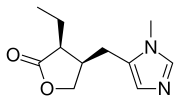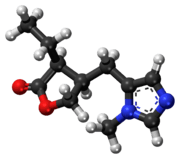Pilocarpine
 | |
 | |
| Clinical data | |
|---|---|
| Trade names | Isopto Carpine, Salagen, others |
| AHFS/Drugs.com | Monograph |
| MedlinePlus | a608039 |
| Pregnancy category | |
| Routes of administration | topical (eye drops), by mouth |
| Drug class | Miotic (cholinergic)[1] |
| ATC code | |
| Legal status | |
| Legal status | |
| Pharmacokinetic data | |
| Elimination half-life | 0.76 hours (5 mg), 1.35 hours (10 mg)[2] |
| Excretion | urine |
| Identifiers | |
| |
| CAS Number | |
| PubChem CID | |
| IUPHAR/BPS | |
| DrugBank | |
| ChemSpider | |
| UNII | |
| KEGG | |
| ChEBI | |
| ChEMBL | |
| ECHA InfoCard |
100.001.936 |
| Chemical and physical data | |
| Formula | C11H16N2O2 |
| Molar mass | 208.257 g/mol |
| 3D model (JSmol) | |
| |
| |
| (verify) | |
Pilocarpine is a medication used to treat increased pressure inside the eye and dry mouth.[3] As eye drops it is used for angle closure glaucoma until surgery can be performed, ocular hypertension, open angle glaucoma, and to bring about constriction of the pupil following its dilation.[1][4] Onset of effects with the drops is typically within an hour and lasts for up to a day.[1] By mouth it is used for dry mouth as a result of Sjogren's syndrome or radiation therapy.[3]
Common side effects of the eye drops include irritation of the eye, increased tearing, headache, and blurry vision.[1] Other side effects include allergic reactions and retinal detachment.[1] Use is generally not recommended during pregnancy.[5] Pilocarpine is in the miotics family of medication.[6] It works by activating cholinergic receptors of the muscarinic type which cause the trabecular meshwork to open and the aqueous humor to drain from the eye.[1]
Pilocarpine was isolated in 1874.[7] It is on the World Health Organization's List of Essential Medicines, the most effective and safe medicines needed in a health system.[8] The wholesale cost in the developing world is about 1.61 to 4.88 USD per 10 ml bottle.[9] In the United States a month of the drops costs less than 25 USD.[3] It was originally made from the South American plant Pilocarpus.[7]
Medical uses
Pilocarpine stimulates the secretion of large amounts of saliva and sweat.[10] It is used to treat dry mouth (xerostomia), particularly in Sjögren's syndrome, but also as a side effect of radiation therapy for head and neck cancer.
It has also been used in the treatment of chronic open-angle glaucoma and acute angle-closure glaucoma for over 100 years.[11] It acts on a subtype of muscarinic receptor (M3) found on the iris sphincter muscle, causing the muscle to contract -resulting in pupil constriction (miosis). Pilocarpine also acts on the ciliary muscle and causes it to contract. When the ciliary muscle contracts, it opens the trabecular meshwork through increased tension on the scleral spur. This action facilitates the rate that aqueous humor leaves the eye to decrease intraocular pressure.
In ophthalmology, pilocarpine is also used to reduce the possibility of glare at night from lights when the patient has undergone implantation of phakic intraocular lenses; the use of pilocarpine would reduce the size of the pupils, relieving these symptoms. The most common concentration for this use is pilocarpine 1%, the weakest concentration. Pilocarpine is shown to be just as effective as apraclonidine in preventing intraocular pressure spikes after laser trabeculoplasty.[12]
Pilocarpine is used to stimulate sweat glands in a sweat test to measure the concentration of chloride and sodium that is excreted in sweat. It is used to diagnose cystic fibrosis.[13]
Adverse effects
Use of pilocarpine may result in a range of adverse effects, most of them related to its non-selective action as a muscarinic receptor agonist. Pilocarpine has been known to cause excessive salivation, sweating, bronchial mucus secretion, bronchospasm, bradycardia, vasodilation, and diarrhea. Eye drops can result in brow ache and chronic use in miosis.
Systemic injection of pilocarpine can compromise the blood brain barrier allowing pilocarpine to gain access to the brain which can lead to chronic epilepsy. Epilepsy induced by injected pilocarpine has been used to develop animal models in rodents in order to study human epilepsy.
Society and culture
Preparation
Plants in the genus Pilocarpus are the only known sources of pilocarpine, and commercial production is derived entirely from the leaves of Pilocarpus microphyllus (Maranham Jaborandi). This genus grows only in South America, and Pilocarpus microphyllus is native to several states in northern Brazil.[14]
Pilocarpine is extracted from the powdered leaf material in a multi-step process. First the material is treated with ethanol acidified with hydrochloric acid, and the solvents removed under reduced pressure. The resultant aqueous residue is neutralized with ammonia and put aside until the resin has completely settled. It is then filtered and concentrated by sugar solution to a small volume, made alkaline with ammonia, and finally extracted with chloroform. The solvent is removed under reduced pressure.
Trade names
Pilocarpine is available under several trade names such as: Diocarpine (Dioptic), Isopto Carpine (Alcon), Miocarpine (CIBA Vision), Ocusert Pilo-20 and -40 (Alza), Pilopine HS (Alcon), Salagen (MGI Pharma), Scheinpharm Pilocarpine (Schein Pharmaceutical), and Timpilo (Merck Frosst).
Research
Pilocarpine is used to induce chronic epilepsy in rodents, commonly rats, as a means to study the disorder's physiology and to examine different treatments.[15] Smaller doses may be used to induce salivation in order to collect samples of saliva, for instance, to obtain information about IgA antibodies.
Veterinary
Pilocarpine is given in moderate doses (about 2 mg) to induce emesis in cats that have ingested foreign plants, foods, or drugs. One feline trial determined it was effective, even though the usual choice of emetic is xylazine.
See also
- Cevimeline—a similar parasympathomimetic medication for dry mouth (xerostomia)
- Bethanechol—a similar muscarinic parasympathomimetic with longer lasting effect
References
- 1 2 3 4 5 6 "Pilocarpine". The American Society of Health-System Pharmacists. Archived from the original on 28 December 2016. Retrieved 8 December 2016.
- ↑ Mervyn Gornitsky; George Shenouda; Khalil Sultanem; Howard Katz; Michael Hier; Martin Black; Ana M Velly (2004). "Double-blind randomized, placebo-controlled study of pilocarpine to salvage salivary gland function during radiotherapy of patients with head and neck cancer". Oral Surgery, Oral Medicine, Oral Pathology, Oral Radiology and Endodontology. 98 (1): 45–52.
- 1 2 3 Hamilton, Richart (2015). Tarascon Pocket Pharmacopoeia 2015 Deluxe Lab-Coat Edition. Jones & Bartlett Learning. pp. 254, 412. ISBN 9781284057560.
- ↑ WHO Model Formulary 2008 (PDF). World Health Organization. 2009. p. 439. ISBN 9789241547659. Archived (PDF) from the original on 13 December 2016. Retrieved 8 December 2016.
- ↑ "Pilocarpine ophthalmic Use During Pregnancy | Drugs.com". www.drugs.com. Archived from the original on 28 December 2016. Retrieved 28 December 2016.
- ↑ British national formulary : BNF 69 (69 ed.). British Medical Association. 2015. p. 769. ISBN 9780857111562.
- 1 2 Sneader, Walter (2005). Drug Discovery: A History. John Wiley & Sons. p. 98. ISBN 9780471899792. Archived from the original on 2016-12-29.
- ↑ "WHO Model List of Essential Medicines (19th List)" (PDF). World Health Organization. April 2015. Archived (PDF) from the original on 13 December 2016. Retrieved 8 December 2016.
- ↑ "Pilocarpine". International Drug Price Indicator Guide. Retrieved 8 December 2016.
- ↑ "Pilocarpine". Archived from the original on 2010-03-06.
- ↑ Rosin, A. (1991). "Pilocarpine. A miotic of choice in the treatment of glaucoma has passed 110 years of use". Oftalmologia. Romania. 35 (1): 53–55. PMID 1811739.
- ↑ Zhang L, Weizer JS, Musch DC (2017). "Perioperative medications for preventing temporarily increased intraocular pressure after laser trabeculoplasty". Cochrane Database Syst Rev. 2 (2): CD010746. doi:10.1002/14651858.CD010746.pub2. PMC 5477062. PMID 28231380.
- ↑ Prasad, Raj K. (2017-07-11). Chemistry and Synthesis of Medicinal Agents: (Expanding Knowledge of Drug Chemistry). BookRix. ISBN 9783743821415.
- ↑ De Abreu, Ilka Nacif; Sawaya, Alexandra Cristine H. F.; Eberlin, Marcos Nogueira; Mazzafera, Paulo (November–December 2005). "Production of Pilocarpine in Callus of Jaborandi (Pilocarpus microphyllus Stapf)". In Vitro Cellular & Developmental Biology. Plant. Society for In Vitro Biology. 41 (6): 806–811. JSTOR 4293939.
- ↑ Morimoto, K; Fahnestock, M; Racine, RJ (May 2004). "Kindling and status epilepticus models of epilepsy: rewiring the brain". Progress in Neurobiology. 73 (1): 1–60. doi:10.1016/j.pneurobio.2004.03.009. PMID 15193778.